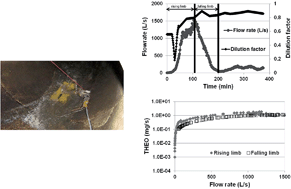Temporal analysis of E. coli, TSS and wastewater micropollutant loads from combined sewer overflows: implications for management†
Abstract
A combined sewer overflow (CSO) outfall was monitored to assess the impact of temporal mass loads on the appropriateness of treatment options. Instantaneous loads (mass per s) varied by approximately three orders of magnitude during events (n = 9 in spring, summer and the fall) with no significant seasonal variations. The median fraction of total loads discharged with the first 25% of the total volume ranged from 28% (theophylline) to 40% (Total Suspended Solids (TSS)) and loads remained high for the duration of the events. E. coli and TSS loads originated primarily from wastewater (WW) (63% and 75%, respectively). However, a mix of stormwater (SW) and sewer deposit (SD) resuspension contributed from 73 to 95% for the first 50% of the volume discharged of total TSS loads for 2 events. The contribution of SD resuspension was not negligible for Wastewater Micropollutants (WWMPs), especially for carbamazepine. Sustained high loads over the course of CSOs highlight the need to revisit current CSO and SW management strategies that focus on the treatment of early discharge volumes.


 Please wait while we load your content...
Please wait while we load your content...